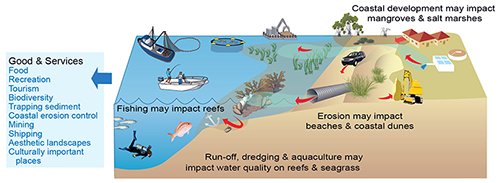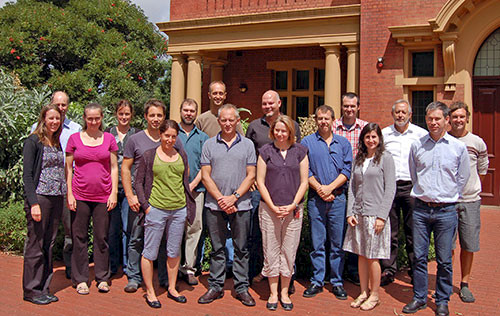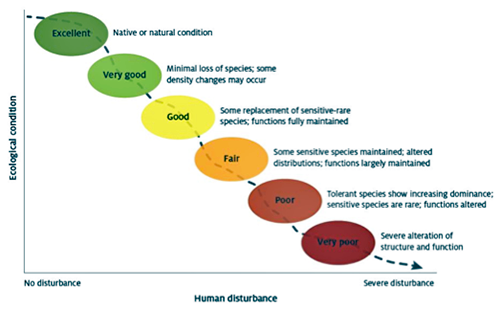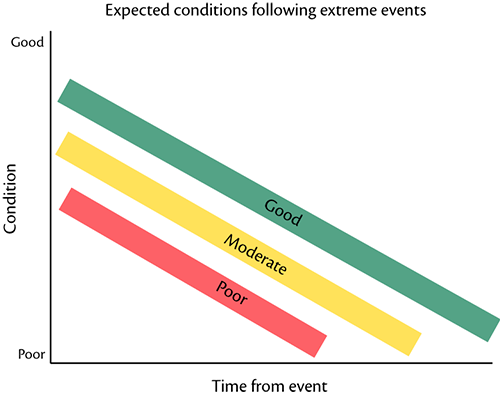A New IAN Science Communication Course on Ecosystem Health Report Cards in Adelaide, Australia
Heath Kelsey ·Alex Fries and I had the chance to travel to Adelaide, Australia to deliver a two-day Science Communication Course to the South Australia Department of Environment, Water, and Natural Resources (DEWNR). The course focused on Ecosystem Health Report Cards. DEWNR is currently creating state-wide report cards in the marine, freshwater, terrestrial, and atmospheric environments, reporting on elements like pest species, soil health, reefs, seagrass, salt marsh, and dunes. These report cards use conceptual diagrams and the IAN symbol libraries.

Because DEWNR is already engaged in the development of report cards, we designed an intermediate level course to infuse the broad IAN style of science communication into report card products, using the 5-step report card process. We used the report cards and diagrams developed by both DEWNR and IAN to develop 5 new modules to support the 5-step report card process. Our new modules include both old and new activities, and represent a new and exciting offering to our science communication courses.
The modules offered in this course included:
- Introduction to the IAN approach to Science Communication
- The 5-steps of the IAN Report Card Process
- The IAN approach to report card design, outreach, and dissemination
- Developing your own communication strategy
- IAN perspectives on monitoring programs and report cards
The 5-steps of the IAN Report Card process includes:
- Step 1. Workshop organization and elements, and the IAN conceptualization process
- Step 2. Choosing appropriate indicators
- Step 3. Approaches to developing thresholds
- Step 4. Considerations for scoring
- Step 5. Developing the communication products
Each one of these new modules has a new introductory PowerPoint and a set of activities that may be used in a workshop setting. Most of these activities were demonstrated during the workshop, but some were presented as options for facilitators to use when conducting their own workshops.

As usual, we learned a great deal from interacting with colleagues in a new region. We heard about the difficulties in integrating science and management, the politics that can sometimes reduce the impact of good science communication, the familiar desire of the science community to increase the level of detail in communications, and the desire of management to reduce the level of detail provided.
We also learned of some new and interesting concepts in ecosystem assessment and management, which will be useful in our quest to provide improved communication of complex issues. In particular, I was struck by two concepts that will assist us in reflecting on resilience and vulnerability, as well as assessing the impacts of extreme events on ecosystem condition.
1. Viewing condition within a scale of human disturbance
A common theme we encounter is the need to put ecosystem condition in the context of the system’s human impact. For example, a highly urbanized system would be expected to have a more degraded ecosystem than a less impacted system like a forested watershed. This relationship can be used to evaluate relative ecosystem health, vulnerability, and resilience.

2. Expected conditions following extreme events
Evaluating ecosystem condition in relation to extreme events can also be challenging. We expect that hurricanes, cyclones, tsunamis, heat waves, etc. will have impacts on the systems we study, but it is difficult to assess overall ecosystem health in the presence of these events.
A concept of expected ecosystem health declines over time following an event was presented to us by Dr. Glen Scholtz from DEWNR, which derived from evaluating river reaches that become hydrologically isolated following the rainy season. Ecosystem condition and water quality are expected to decline in a predictable way following cessation of flow; the relationship between condition and time since flow cessation can be used to determine relative ecosystem condition.

References
Davies, SP, and SK Jackson. 2006. The biological condition gradient: a descriptive model for interpreting change in aquatic ecosystems. Ecological Applications, 16:1251-1266.
Scholtz, Glen. Personal communication, 18 February 2014.
About the author
Heath Kelsey

Heath Kelsey has been with IAN since 2009, as a Science Integrator, Program Manager, and as Director since 2019. His work focuses on helping communities become more engaged in socio-environmental decision making. He has over 15-years of experience in stakeholder engagement, environmental and public health assessment, indicator development, and science communication. He has led numerous ecosystem health and socio-environmental health report card projects globally, in Australia, India, the South Pacific, Africa, and throughout the US. Dr. Kelsey received his MSPH (2000) and PhD (2006) from The University of South Carolina Arnold School of Public Health. He is a graduate of St Mary’s College of Maryland (1988), and was a Peace Corps Volunteer in Papua New Guinea from 1995-1998.

